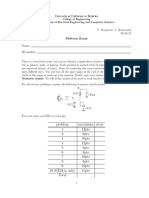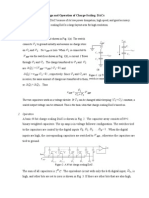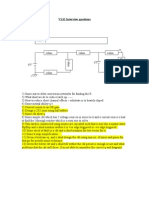Numerical S 1
Numerical S 1
Uploaded by
christinadaniel2104Copyright:
Available Formats
Numerical S 1
Numerical S 1
Uploaded by
christinadaniel2104Original Title
Copyright
Available Formats
Share this document
Did you find this document useful?
Is this content inappropriate?
Copyright:
Available Formats
Numerical S 1
Numerical S 1
Uploaded by
christinadaniel2104Copyright:
Available Formats
EECS 151/251A Homework 6
Due Friday, October 21st , 2022 11:59PM
Problem 1: CMOS Gates
(a) What is the boolean expression for the function described by the CMOS gate below?
Solution:
We can look at the PDN to observe the boolean expression, converting parallel branches
to boolean ORs and series to boolean ANDs:
Out = A(B + C) + D (1)
Version: 1.3 - 2022-10-24 19:56:14Z
EECS 151/251A Homework 6 2
(b) Draw the static complementary CMOS circuit that implements the following logic function:
ABC + DE
Solution:
The output is 0 when ABC +DE is true, so the PDN can directly map to this expression.
Hence there are 2 parallel branches in the PDN, with A/B/C in series on one branch and
D/E in series on the other branch.
The PUN can be derived by applying the duality of complementary CMOS gates. Series
paths are converted to parallel, and parallel paths are converted to series. This results in
2 groups of transistors in series, with one group being A/B/C in parallel and the other
being D/E in parallel.
Version: 1.3 - 2022-10-24 19:56:14Z
EECS 151/251A Homework 6 3
Problem 2: Inverter Delay
We want to design a 5-stage inverter chain that can drive a load capacitance of CL = 250Cin with
the smallest delay possible, where Cin is the input capacitance of a minimum sized inverter. The
first inverter is constrained to be minimum size (W = 1 as in shown in the figure). Assume that
τinv = 10 ps and γ = 1.
(a) How should the inverter chain be sized for minimum delay?
Solution:
Delay is minimized when each stage has the same fanout. The total fanout is
CL 250Cin
F = = = 250
Cin Cin
The fanout per stage should then be
√ √
f= F = 250 ≈ 3.02
N 5
We can then size the inverters from the back:
CL 250Cin
Cd = = ≈ 82.9Cin ⇒ d ≈ 82.9
f 3.02
Cd 82.9Cin
Cc = = ≈ 27.5Cin ⇒ c ≈ 27.5
f 3.02
CL 27.5Cin
Cb = = ≈ 9.1Cin ⇒ b ≈ 9.1
f 3.02
CL 9.1Cin
Ca = = ≈ 3.02Cin ⇒ a ≈ 3.02
f 3.02
(b) What is the total delay through the inverter chain?
Solution:
tp,tot = τinv · N (γ + f ) = 10 · 5(1 + 3.02) ≈ 201ps
Version: 1.3 - 2022-10-24 19:56:14Z
EECS 151/251A Homework 6 4
(c) Assume that the number of stages is not restricted to 5. How many stages should you use for
minimum delay? What is the total delay?
Solution:
The total (normalized) delay through the inverter chain as a function of N (the number
of stages), F (the total fanout), and γ is
D = N (γ + F 1/N )
Using F = 250 and γ = 1, we can plot the delay curve:
The graph shows that the optimal number of stages is 4. Thus, the total delay is
tp,tot = τinv · N (γ + F 1/N ) = 10 · 4(1 + 2501/4 ) ≈ 199ps
Version: 1.3 - 2022-10-24 19:56:14Z
EECS 151/251A Homework 6 5
Problem 3: Logical Effort
In the lecture, we mentioned that inverters in today’s FinFET technology nodes have equal NMOS
and PMOS widths since the Ron,n = Ron,p . Here, we assume a different technology, where for a
minimum size transistor (W = 1),
• NMOS on resistance Ron,n = R
• PMOS on resistance Ron,p = 3R
• Gate capacitance Cg = C (same for both NMOS and PMOS)
Assume γ = 1.
(a) How should the minimum inverter be sized? Specify the NMOS width Wn and PMOS width
Wp .
Solution:
Wn = 1, Wp = 3.
We want equal pull-down/pull-up strengths. Wn = 1 would result in a pull-down resis-
tance of R, and Wp = 3 would result in a pull-up resistance of 3R/3 = R.
(b) What is Req and Cin of the minimum size inverter?
Solution:
Req = R, Cin = 4C.
As mentioned in the solution to part (a), the minimum size inverter is sized to have a
pull-up and pull-down resistance of R.
The total input capacitance is
Cg,n + Cg,p = Wn Cg + Wp Cg = C + 3C = 4C
Version: 1.3 - 2022-10-24 19:56:14Z
EECS 151/251A Homework 6 6
(c) We want to design the following custom CMOS gate:
How should the custom gate be sized to have the same output current as the minimum size
inverter?
Solution:
We want to size each transistor such that in the worst case, the pull-up/pull-down resis-
tance is equivalent to that of the minimum size inverter (i.e., R). For parallel branches,
the worst case considers only one branch being on at a time.
First, consider the pull-down network. The NMOS with input C should be sized 1 to
have a PD resistance of R. As for the NMOS with inputs A and B, both transistors
must be on, resulting in 2x the resistance. Thus, each should be sized 2 such that the
PD resistance in this case is R/2 + R/2 = R.
Next, consider the pull-up network. For the PUN to be turned on, all branches must
require a stack of 2 PMOS devices to be on (either A & C or B & C). Thus, each PMOS
must be sized 2x larger to account for the 2-stacked PMOS. In addition, PMOS must be
3x larger than the NMOS to account for the 3x larger on-resistance. Hence, setting the
PMOS devices to have size 6 results in the PU resistances as
Ron,p Ron,p 3R 3R
A, C : + = + =R
WA WC 6 6
Ron,p Ron,p 3R 3R
B, C : + = + =R
WB WC 6 6
Version: 1.3 - 2022-10-24 19:56:14Z
EECS 151/251A Homework 6 7
(d) Compute the logical effort LE and (normalized) parasitic delay P of the custom gate.
Note: The logical effort should be calculated separately for each input.
Solution:
The logical effort is computed as
Req,gate Cin,gate
LE =
Req,inv Cin,inv
Because we sized the custom gate to have the same resistance as the inverter,
Req,gate = Req,inv
and the LE equation simplifies to the ratio of capacitances, or
Cin,gate
LE =
Cin,inv
We can first compute the gate input capacitance for each input:
Cin,A = Cg (Wn,A + Wp,A ) = Cg (2 + 6) = 8C
Cin,B = Cg (Wn,B + Wp,B ) = Cg (2 + 6) = 8C
Cin,C = Cg (Wn,C + Wp,C ) = Cg (1 + 6) = 7C
The logical effort for each input is then
Cin,A 8C
LEA = = =2
Cin,inv 4C
Cin,B 8C
LEB = = =2
Cin,inv 4C
Cin,C 7C
LEC = = = 1.75
Cin,inv 4C
The (normalized) parasitic delay is computed as
Req,gate Cp,gate
P =
Req,inv Cp,inv
As in the case with logical effort,
Req,gate = Req,inv
and the parasitic delay equation simplifies to the ratio of capacitances, or
Cp,gate
P =
Cp,inv
Version: 1.3 - 2022-10-24 19:56:14Z
EECS 151/251A Homework 6 8
There are 4 transistors whose drains are directly connected to the output: the NMOS
with input B, NMOS with input C, PMOS with input A, and PMOS with input B. The
parasitic output cap of the gate is thus
γCg (Wn,B + Wn,C + Wp,A + Wp,B ) = 15γC
The parasitic output cap of the inverter is
γCg (Wn + Wp ) = 4γC
Thus, the parasitic delay is
15γC 15
P = = = 3.75
4γC 4
(e) (251A Only) Suppose that we have the following data path:
An inverter drives the custom gate’s input A, and the custom gate drives a load capacitance
CL = 16C. Both the inverter and custom gate are minimum size (as denoted by "1" in the
figure). Assume that the custom gate’s inputs B and C are driven by other circuits not shown
here.
What is the total delay from the input to the output? Express in terms of R and C.
Solution:
The total delay can be expressed in terms of parasitic delays, logical effort, and fanout:
tp,tot = tp,inv + tp,gate
= τinv (γ + finv ) + τinv (Pgate + LEgate,A fgate )
The fanout of the inverter is finv = 1 since the custom gate is sized to be 1 (i.e., its input
cap is the same as the minimum size inverter, or 4C).
The fanout of the custom gate is
CL 16C
fgate = = =4
4C 4C
Version: 1.3 - 2022-10-24 19:56:14Z
EECS 151/251A Homework 6 9
Thus, the total delay is
tp,tot = τinv [(γ + finv ) + (γ · Pgate + LEgate,A fgate )]
= τinv [(1 + 1) + (1 · 3.75 + 2 × 4)]
= 13.75τinv
= 13.75(4 ln 2RC) ≈ 38.1RC
Version: 1.3 - 2022-10-24 19:56:14Z
You might also like
- Chapter6 Ex SolDocument26 pagesChapter6 Ex SolShivani YadavNo ratings yet
- Ee141 Hw4 SolDocument16 pagesEe141 Hw4 SolVidhya Ds100% (1)
- HW 6Document4 pagesHW 6pskumarvlsipdNo ratings yet
- Assignment IDocument2 pagesAssignment Ivaishnavi priyaNo ratings yet
- BJT ModelsDocument6 pagesBJT ModelsArmor BatsNo ratings yet
- ECE 410 Homework 6 - Solution Spring 2008Document4 pagesECE 410 Homework 6 - Solution Spring 2008murthyNo ratings yet
- University of California, Berkeley College of Engineering Department of Electrical Engineering and Computer Sciences Elad Alon Homework #4 EECS141Document2 pagesUniversity of California, Berkeley College of Engineering Department of Electrical Engineering and Computer Sciences Elad Alon Homework #4 EECS141Vidhya DsNo ratings yet
- Lec 9 Super Buffer DesignDocument8 pagesLec 9 Super Buffer DesignAbhishek Gowda100% (1)
- Midterm Exam Name: ID NumberDocument18 pagesMidterm Exam Name: ID NumberpskumarvlsipdNo ratings yet
- Bias Flyback App NoteDocument8 pagesBias Flyback App NoteHassanNo ratings yet
- Devices Lab6Document11 pagesDevices Lab6Samar AgarwalNo ratings yet
- CMOS Comparators: Analog Integrated Circuit DesignDocument30 pagesCMOS Comparators: Analog Integrated Circuit Designshriniwas ghadyaljiNo ratings yet
- AmplifierDocument20 pagesAmplifierHua-Chien ChangNo ratings yet
- EC3058D-VLSI Circuits and Systems Winter Semester-2020-21Document2 pagesEC3058D-VLSI Circuits and Systems Winter Semester-2020-21Gamer AnonymousNo ratings yet
- 2010_test2Document7 pages2010_test2Zadam MohammedNo ratings yet
- Euler's PathDocument10 pagesEuler's PathSatish Kumar0% (1)
- Written Exam AnswersDocument21 pagesWritten Exam AnswersBiproNo ratings yet
- hw04 f05 SolnDocument4 pageshw04 f05 SolnSidXDDD a.k.a. wk96No ratings yet
- Ch6 I MOS Inverters Switching Characteristics I 2 13Document13 pagesCh6 I MOS Inverters Switching Characteristics I 2 13asad_raza4uNo ratings yet
- Lab 4Document8 pagesLab 4Binod AdhikariNo ratings yet
- Chapter 3. Single-Transistor Primitives An Intuitive Approach (Analog IC Design An Intuitive Approach)Document26 pagesChapter 3. Single-Transistor Primitives An Intuitive Approach (Analog IC Design An Intuitive Approach)Minh Hai RungNo ratings yet
- Rectangular - Columns As Per ACI-318 Using MathcadDocument11 pagesRectangular - Columns As Per ACI-318 Using Mathcadkartik vNo ratings yet
- Ee141 HW5 2Document3 pagesEe141 HW5 2Vidhya DsNo ratings yet
- CS - Chapter 6 (Part 2) PDFDocument59 pagesCS - Chapter 6 (Part 2) PDFYuukiaNo ratings yet
- VDD 2.5V: To Dsat 2 0.5 - 1 Ox 2 o J 2 JSWDocument5 pagesVDD 2.5V: To Dsat 2 0.5 - 1 Ox 2 o J 2 JSWdigi1988No ratings yet
- Switched-Capacitor Filters: - "Analog" Sampled-Data FiltersDocument24 pagesSwitched-Capacitor Filters: - "Analog" Sampled-Data FiltersPushpendra DwivediNo ratings yet
- Lab7 ProjectDocument9 pagesLab7 Projectanujyadav10457No ratings yet
- Multistage Amplifiers: Bipolar Junction Transistor: MosfetDocument16 pagesMultistage Amplifiers: Bipolar Junction Transistor: MosfetRomelDianonNo ratings yet
- 2020 Ques Mid AdvdDocument1 page2020 Ques Mid AdvdSABUJ CHAKINo ratings yet
- Soln AE09Document48 pagesSoln AE09Santosh Kumar SharmaNo ratings yet
- Exercise 2Document3 pagesExercise 2momolololilo4No ratings yet
- Nitin Capacitor DPPDocument38 pagesNitin Capacitor DPPrjn.mathsNo ratings yet
- Lecture 03 13 PDFDocument35 pagesLecture 03 13 PDFShahAyzdiiNo ratings yet
- Inductor and Transformer Design: Problem 1Document14 pagesInductor and Transformer Design: Problem 1hans_alayoNo ratings yet
- Nielit Cs 65 PDFDocument32 pagesNielit Cs 65 PDFNeha KumariNo ratings yet
- Charge Scaling DACDocument7 pagesCharge Scaling DACmilostar6No ratings yet
- Solved ISRO Scientist or Engineer Electronics 2018 Paper With SolutionsDocument30 pagesSolved ISRO Scientist or Engineer Electronics 2018 Paper With Solutionsanshu8877947678No ratings yet
- Ee 347 HW 4Document12 pagesEe 347 HW 4Majo CoteNo ratings yet
- Exams Questions Papers Sec1 5Document104 pagesExams Questions Papers Sec1 5Franz BonzonNo ratings yet
- Chapter 9Document18 pagesChapter 9Abhinav GuptaNo ratings yet
- Freq Response of BJT AmplifierDocument6 pagesFreq Response of BJT AmplifierAnonymous jiembd100% (1)
- Lecture35 140626Document33 pagesLecture35 140626ponnada018No ratings yet
- Carry Save Adder Implementation: in OutDocument10 pagesCarry Save Adder Implementation: in Outsunayana_ghosh2001No ratings yet
- Model VLSI Question PaperDocument7 pagesModel VLSI Question Paperkumar_eeeNo ratings yet
- Design FrequencyDocument5 pagesDesign FrequencyGustavo SánchezNo ratings yet
- Hybrid PieDocument6 pagesHybrid PieAman GuptaNo ratings yet
- General Instructions To The CandidateDocument4 pagesGeneral Instructions To The Candidateapurv shuklaNo ratings yet
- F2018 - EE223 Homework#2Document2 pagesF2018 - EE223 Homework#2Shubham JaiswalNo ratings yet
- PS3 SolutionsDocument7 pagesPS3 SolutionsMs RasekhNo ratings yet
- Capacitance Cheat CodeDocument13 pagesCapacitance Cheat CodeADITYA UPADHYAYNo ratings yet
- Exam Questions-Section 1Document38 pagesExam Questions-Section 1Gecca VergaraNo ratings yet
- VLSI Interview QuestionsDocument112 pagesVLSI Interview QuestionsrAM100% (10)
- Easy(er) Electrical Principles for Extra Class Ham License (2012-2016)From EverandEasy(er) Electrical Principles for Extra Class Ham License (2012-2016)No ratings yet
- Exercises in Electronics: Operational Amplifier CircuitsFrom EverandExercises in Electronics: Operational Amplifier CircuitsRating: 3 out of 5 stars3/5 (1)
- Easy(er) Electrical Principles for General Class Ham License (2019-2023)From EverandEasy(er) Electrical Principles for General Class Ham License (2019-2023)No ratings yet
- 10+2 Level Mathematics For All Exams GMAT, GRE, CAT, SAT, ACT, IIT JEE, WBJEE, ISI, CMI, RMO, INMO, KVPY Etc.From Everand10+2 Level Mathematics For All Exams GMAT, GRE, CAT, SAT, ACT, IIT JEE, WBJEE, ISI, CMI, RMO, INMO, KVPY Etc.No ratings yet
- Easy(er) Electrical Principles for General Class Ham License (2015-2019)From EverandEasy(er) Electrical Principles for General Class Ham License (2015-2019)Rating: 5 out of 5 stars5/5 (1)
- DM7445 BCD To Decimal Decoders/Drivers: General Description FeaturesDocument4 pagesDM7445 BCD To Decimal Decoders/Drivers: General Description FeaturesSyaiful RahmanNo ratings yet
- Extech 382285Document1 pageExtech 382285AndrewNo ratings yet
- Unit - II GpioDocument18 pagesUnit - II GpioSai CharanNo ratings yet
- Digital Electronics MCQDocument13 pagesDigital Electronics MCQAyush Gupta 4-Year B.Tech. Electrical EngineeringNo ratings yet
- A Transistor May Be Operated in Three Different ConfigurationsDocument7 pagesA Transistor May Be Operated in Three Different ConfigurationsApurva NagdeoteNo ratings yet
- SDIC 11marks (Q & A) (Unit 2)Document10 pagesSDIC 11marks (Q & A) (Unit 2)Ganapathy RamadossNo ratings yet
- 8-Bit Serial-Input/Serial or Parallel-Output Shift Register With Latched 3-State OutputsDocument10 pages8-Bit Serial-Input/Serial or Parallel-Output Shift Register With Latched 3-State Outputsmiki_jamNo ratings yet
- VLSIDocument3 pagesVLSIAnusha MNo ratings yet
- Question Bank DSDDocument6 pagesQuestion Bank DSDJithinmvijayan VijayanNo ratings yet
- BEE UNIT 1 Lecture 2 RLC SourceDocument14 pagesBEE UNIT 1 Lecture 2 RLC Sourcetanmay sonawaneNo ratings yet
- Mitsubishi RA RDDocument12 pagesMitsubishi RA RDИгорьNo ratings yet
- Vlsi Design Instruction Manual With SolutionDocument65 pagesVlsi Design Instruction Manual With SolutionSujal Dubey ,FYCO 3 Roll no. 15No ratings yet
- Ebook PDF Digital Design Principles and Practices 5th Edition by John F Wakerly PDFDocument41 pagesEbook PDF Digital Design Principles and Practices 5th Edition by John F Wakerly PDFconstance.elrod722100% (44)
- Analog Electronics Lab 6Document5 pagesAnalog Electronics Lab 6Usman AslamNo ratings yet
- Registers & Counters: Mantıksal Tasarım - BBM231 M. Önder Efe Onderefe@cs - Hacettepe.edu - TRDocument42 pagesRegisters & Counters: Mantıksal Tasarım - BBM231 M. Önder Efe Onderefe@cs - Hacettepe.edu - TRDayanand Gowda KrNo ratings yet
- Telescopic OP AMP DesignDocument17 pagesTelescopic OP AMP DesignSAMI UR REHMANNo ratings yet
- Traffic LightDocument19 pagesTraffic LightDianne ParNo ratings yet
- India Bix 2Document59 pagesIndia Bix 2CrichelleMaeNo ratings yet
- Unit 4 - Digital Systems - www.rgpvnotes.in (1)Document26 pagesUnit 4 - Digital Systems - www.rgpvnotes.in (1)DjamenNo ratings yet
- Digital Electronics LAB ManualDocument61 pagesDigital Electronics LAB ManualKiranmai KonduruNo ratings yet
- Examples Chapter 3 Bipolar Junction TransistorsDocument5 pagesExamples Chapter 3 Bipolar Junction Transistorshamza abdo mohamoudNo ratings yet
- DHA Suffa University Department of Computer Science CS 1101L Digital Logic Design Spring 2021Document3 pagesDHA Suffa University Department of Computer Science CS 1101L Digital Logic Design Spring 2021Tayyab ShafiqNo ratings yet
- EST Chapter 3 Pages 40-48Document14 pagesEST Chapter 3 Pages 40-48Nico RobinNo ratings yet
- Ec8351 Electronic Circuits I 1901883722 Ec8351 Ec IDocument19 pagesEc8351 Electronic Circuits I 1901883722 Ec8351 Ec IyogiNo ratings yet
- What Is A Diode?: Current ResistanceDocument14 pagesWhat Is A Diode?: Current ResistanceAmin RahmanNo ratings yet
- Exp 4 - Class B AmplifierDocument6 pagesExp 4 - Class B Amplifiervanitha100% (1)
- Philips Technical Review: The PM 2517 Automatic Digital MultimeterDocument14 pagesPhilips Technical Review: The PM 2517 Automatic Digital MultimetermaricelluscanNo ratings yet
- Chip Builder GPTDocument35 pagesChip Builder GPT123idk456lmaoNo ratings yet
- A 2-10 Ghz Ultra-Wideband Common-Gate Low Noise Amplifier Using Body Bias Technique In 0.18 Μm CmosDocument5 pagesA 2-10 Ghz Ultra-Wideband Common-Gate Low Noise Amplifier Using Body Bias Technique In 0.18 Μm CmosPranjal JalanNo ratings yet
- BL24C32Document15 pagesBL24C32no188No ratings yet

























































































